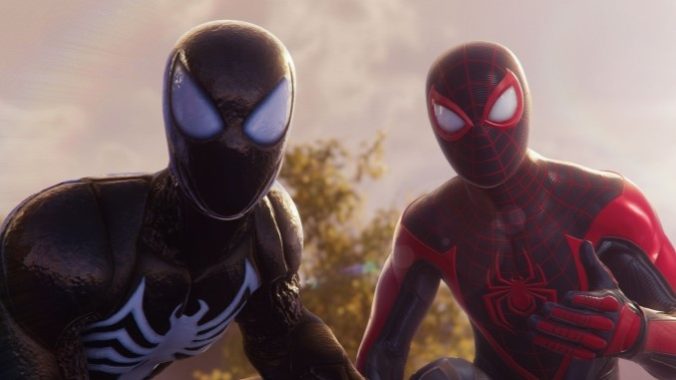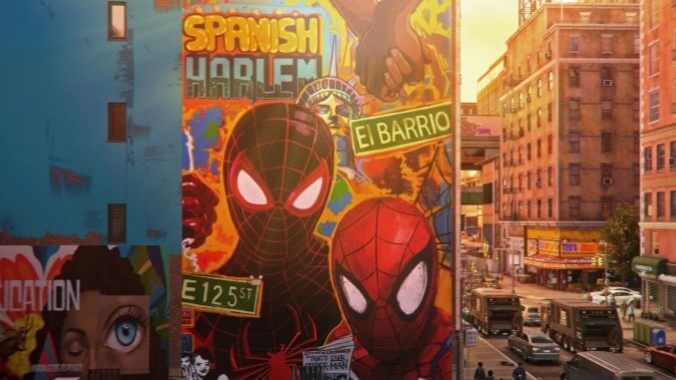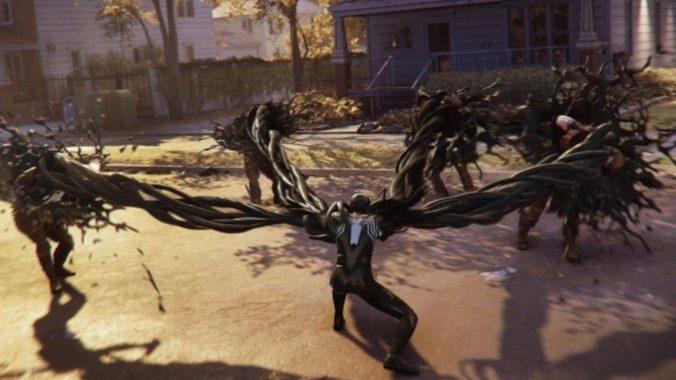Marvel’s Spider-Man 2 Is A Balancing Act That Gets It Mostly Right
Games Reviews Marvel's Spider-Man 2
Marvel’s Spider-Man 2 is a blockbuster sequel, complete with all the baggage that phrase summons. It is a modest improvement on the already solid foundation provided by the first two games, which set up both the protagonists of this latest installment, Peter Parker and Miles Morales. New York is bigger than before, with parts of Queens and Brooklyn making the cut and the Spider-Mans (Spider-Men? Spiders-Man? Spider-Guys? I don’t know) have more than ever to contend with as Kraven comes into town, the Lizard is let loose on New York again, and a symbiote paves the way for Venom. Both Peter and Miles have abilities that make them standout and both have things going on in their lives that’s causing some turmoil. If this sounds like the plot of any of your favorite Spidey comics, shows, and/or films, it’s because it’s remarkably alike. And while these similarities rob the game of some excitement and novelty, Marvel’s Spider-Man 2 still successfully brings a superhero story to life in thrilling fashion.
There’s first and foremost a lot going on in this Spider-Man 3-shaped sequel. Peter Parker is struggling to balance things between his dream girl, kick-ass superpowers, and the responsibility of protecting New York, not to mention his “mentorship” of an up and coming Spider-Man and his desperate need for a job to pay the bills. All this while mourning the loss of his Aunt May and the illness that’s taken his best friend from him means that Peter is juggling quite a lot. Miles is similarly dealing with the fallout of the past two games, especially the death of his father at the hands of the first game’s primary villain, Martin Li aka Mr. Negative. That and the looming prospect of college, a potential relationship and, once again, stepping up to save New York has him a little frayed too. Balance is a key theme of Marvel’s Spider-Man 2, and an appropriate one given the things the characters and game need to independently deal with. Like the protagonists, the game occasionally falters supporting the sheer amount of conflicts going on at any given point, but it tries and succeeds better than most might.
Splitting the time spent in a game and world between multiple characters is a challenge. How do you make each matter without making it so that the player feels like they’re missing out on something by opting into one over another? How do you partition missions and encounters between them? As far as the story goes, it does disappointingly mean sidelining characters like Miles (whose story I really loved and wished shone a bit brighter) so that Peter’s story with the symbiote and the return of his best friend Harry Osborn can play out on a grander stage. Miles does eventually have his moments and the writers of the game make sure this means he meaningfully intertwines into the larger story of the game especially as things reach a head, but it’s hard to argue this isn’t still Peter’s game and story, given his particular stakes and how the elements central to his narrative tend to steer the game. The (mostly) stunning run of villains in Marvel’s Spider-Man 2 all feel like Peter’s, and most of the emotional payoffs that come towards the end of the game are his too. It’s hard not to feel like the Spideys are less co-pilots than they are a single pilot and some guy tagging along. For what it’s worth, Peter’s side of the story is grand, delivering exhilarating set piece moments and quieter heartfelt beats in equal measure as we untangle his most precious relationships. I just wish the same could be said for Miles.

Peter and Harry’s relationship in particular is the highlight of Marvel’s Spider-Man 2, showing them in a light that decades of blockbuster movies never quite nailed: the absolute best of friends. There’s a real charm to getting to be Peter biking down the road with his best friend who he thought he’d lost till recently. Or breaking into their old stomping grounds and playing through a flashback of their high school hijinx. It’s refreshing to see their relationship free of the toxicity, anger, and envy that has ripped them apart in versions of this story that I’ve seen played out. I love that they are guys who aren’t afraid to frequently declare how important they are to each other and that they love one another frequently and openly. Getting to play as Peter rather than Spider-Man in so many of the sequences that feature Harry may be a bit slow and uninspired, but I found it to be a great reprieve for both myself and the character. Arriving at those parts of the game allowed me and Peter to let the mask slip a little bit; the truth is that being Spider-Man can be exhausting and it is often nice to just not be him and solve little scientific puzzles with your best bud.
This relationship and its importance to the main story of Marvel’s Spider-Man 2 does reveal as I mentioned how inconsequential Miles’ part of the world can sometimes feel though. Ganke, the closest thing Miles has to a Harry analog, remains a “guy in the chair,” and even Hailey, Miles’ friend and love interest, doesn’t get to play a larger role like MJ. Rio, Miles’ mother, similarly plays a relatively small role in things, and his uncle Aaron Davis (or the Prowler) returns in a limited capacity too. Miles’ college ambitions also feel sidelined or outright forgotten after a while. His world just feels smaller—more insulated—and he only really feels like he can make himself stand out when the other Spider-Man falters or isn’t around, which eventually comes around as the story dovetails into the familiar beats of the personality-altering Symbiote. When it’s time for Miles to show up, he does the damn thing though, and I’m reminded of why I’ve grown to love that character so much. Still it feels like a poor excuse to limit Miles and what his pocket of New York can do for the sake of Pete’s story and I do hope the obvious game coming after this one rectifies the balancing act.
Elsewhere, Marvel’s Spider-Man 2 handles the split better, offering a slew of quests either can pursue while doling out a select few character-specific quests that tease out threads of the main plot and future beats. While these deviations from the main story are conventional ones, they are welcome explorations of other characters that help this game’s version of New York feel like it’s bursting with evil to contend with and incredibly cool characters to fight alongside, like the Wraith who figures prominently in my favorite of these side quests. Marvel’s Spider-Man 2 features a startling number of side quests in the sense that it could easily be filled to the brim with useless filler content but simply isn’t. There are less collectibles than there have been in past titles, and by the by, a number of missions (both on the main track and not) that strikes an incredibly sweet spot between the initial game and the shorter Miles-focused follow up rather than ballooning past both. Almost every bit of the content that does find a place in Marvel’s Spider-Man 2 feels far more considered than it has been in the past, and feels like it’s been weighed against the bloat of countless other open-world titles with lower standards. Completing everything the game has to offer is a more tangible goal than players might think, and I did it all in under 30 hours.

Marvel’s Spider-Man 2 feels like the best of the three games Insomniac has managed to put out in this series, and this especially helped me explore the game’s nook and crannies to the extent I managed. Web-swinging feels as seamless and kinetic as ever and, to sell a completely different fantasy, Insomniac has given players wings to sort of fly with. It’s more like a glide, but frequent wind tunnels and rooftop vents make it so that you can essentially fly through the city and even into other boroughs with relative ease. In spots like Astoria, which are mostly residential suburbs and thus close to the ground, it feels nice to have the alternative option, which pairs well with a super jump either Spider-Man can now use. Miles has a slight edge in that his Venom lightning powers include a jump and dash forward that especially give him momentum. These powers also help Miles stand out in combat, emerging as the lither of the two protagonists, whereas Peter and his Spider-Arm tech and Symbiote powers clearly hold more of the brute force. While they stand apart, people will gravitate towards their favorites and will largely find they play them very similarly, especially since they share half their abilities and all their gadgets. Speaking of, as good as it feels to play either, Marvel’s Spider-Man 2‘s combat still feels particularly bloated with techniques and options that feel flashier than they are helpful, and cluttering so many of the face buttons with such different utilities and abilities makes me feel like I’m clumsily making my way through most fights, and there are a lot of fights in this game. Moving forward, I genuinely think the team should revisit how many abilities and gadgets players really need and hopefully pare things back rather than continue growing the respective repertoires and armories. Insomniac has shown that they are reticent to grow without good cause in other areas of the game, and so hopefully they can bring that thinking to how they approach combat.
Besides that hitch, Marvel’s Spider-Man 2 is a largely commendable sequel, building on what’s come before it in smarter ways than I’d put past most AAA titles. It’s an impressively lean and refined take on the open world structure that gives me hope the future isn’t just endless growth. Its familiarity is both a crutch and a boon that Insomniac manages to spin in a mostly good light in order to tell a story we’ve seen before with some key changes that make it land more impactfully than I’ve seen it done in quite some time. Though it sometimes struggles to use the entirety of its cast to great effect, I think what it does accomplish is no small task and more than anything, sets up an exciting future for characters I’ve grown remarkably fond of and can’t wait to see more of. If you’re wondering whether or not this title delivered here and now though, rest easy knowing that yes, it absolutely did.
Marvel’s Spider-Man 2 is developed by Insomniac Games and published by Sony Interactive Entertainment. Our review is based on the PS5 version, which is the platform it’s exclusive to.
Moises Taveras is the assistant games editor for Paste Magazine. He was that one kid who was really excited about Google+ and is still sad about how that turned out.